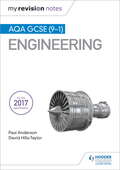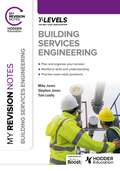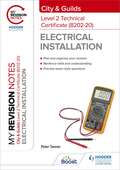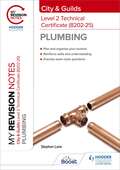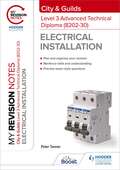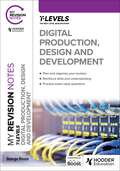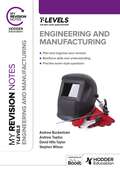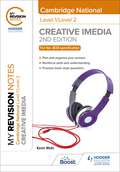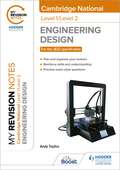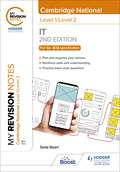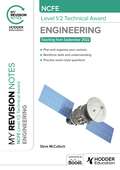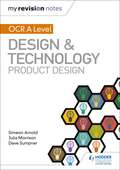- Table View
- List View
My Revision Notes: Aqa Gcse (9-1) Engineering Epub (Mrn Ser.)
by Paul Anderson David Hills-TaylorExam board: AQALevel: GCSESubject: EngineeringFirst teaching: September 2017First exams: Summer 2019Target success in GCSE Engineering with this proven formula for effective, structured revision. Key content coverage is combined with exam-style tasks and practical tips to create a revision guide that students can rely on to review, strengthen and test their knowledge.With My Revision Notes, every student can:- plan and manage a successful revision programme using the topic-by-topic planner- consolidate subject knowledge by working through clear and focused content coverage- test understanding and identify areas for improvement with regular 'Now Test Yourself' tasks and answers- improve exam technique through practice questions, expert tips and examples of typical mistakes to avoid- get exam ready with extra quick quizzes and answers to the practice questions available online.
My Revision Notes: Building Services Engineering T Level
by Stephen Jones Mike Jones Tom LeahyUnlock your full potential with this revision guide that will guide you through the knowledge and skills you need to succeed in the Building Services Engineering T Level core exams.- Plan your own revision and focus on the areas you need to revise with key content summaries and revision activities for every topic- Understand key terms you will need for the exam with user-friendly definitions and a glossary- Breakdown and apply scientific and mathematic principles with clear worked examples- Use the exam tips to clarify key points and avoid making typical mistakes- Test yourself with end-of-topic questions and answers and tick off each topic as you complete it- Get ready for the exam with tips on approaching the paper, and sample exam questions
My Revision Notes: Building Services Engineering T Level
by Stephen Jones Mike Jones Tom LeahyUnlock your full potential with this revision guide that will guide you through the knowledge and skills you need to succeed in the Building Services Engineering T Level core exams.- Plan your own revision and focus on the areas you need to revise with key content summaries and revision activities for every topic- Understand key terms you will need for the exam with user-friendly definitions and a glossary- Breakdown and apply scientific and mathematic principles with clear worked examples- Use the exam tips to clarify key points and avoid making typical mistakes- Test yourself with end-of-topic questions and answers and tick off each topic as you complete it- Get ready for the exam with tips on approaching the paper, and sample exam questions
My Revision Notes: CCEA GCSE Home Economics: Food and Nutrition (My Revision Notes)
by Claire Thomson Nicola AndersonExam board: CCEALevel: GCSESubject: Home EconomicsFirst teaching: September 2017First exams: Summer 2019Target success in CCEA GCSE Home Economics: Food and Nutrition with this proven formula for effective, structured revision. Key content coverage is combined with exam-style tasks and practical tips to create a revision guide that students can rely on to review, strengthen and test their knowledge.With My Revision Notes, every student can:- plan and manage a successful revision programme using the topic-by-topic planner- consolidate subject knowledge by working through clear and focused content coverage- test understanding and identify areas for improvement with regular 'Now Test Yourself' tasks and answers- improve exam technique through practice questions, expert tips and examples of typical mistakes to avoid- get exam ready with extra quick quizzes and answers to the practice questions available online.
My Revision Notes: City & Guilds Level 2 Technical Certificate in Electrical Installation (8202-20)
by Peter TannerUnlock your full potential with this revision guide that will guide you through the content and skills you need to succeed in the City & Guilds Level 2 Technical Certificate in Electrical Installation (8202-20).- Plan your own revision and focus on the areas you need to revise with key content summaries and revision activities for every topic- Understand key terms you will need for the exam with user-friendly definitions and a glossary- Breakdown and apply scientific and mathematic principles with clear worked examples- Use the exam tips to clarify key points and avoid making typical mistakes- Test yourself with end-of-topic questions and answers and tick off each topic as you complete it- Get ready for the exam with tips on approaching the paper, and sample exam questions----'A must for all Level 2 Electrical learners who wish to be successful. It allows students to expand on their basic knowledge to obtain a high score in their exams.' - Neil McManus, Construction T Level Programme Area Manager, Leicester College
My Revision Notes: City & Guilds Level 2 Technical Certificate in Electrical Installation (8202-20)
by Peter TannerUnlock your full potential with this revision guide that will guide you through the content and skills you need to succeed in the City & Guilds Level 2 Technical Certificate in Electrical Installation (8202-20).- Plan your own revision and focus on the areas you need to revise with key content summaries and revision activities for every topic- Understand key terms you will need for the exam with user-friendly definitions and a glossary- Breakdown and apply scientific and mathematic principles with clear worked examples- Use the exam tips to clarify key points and avoid making typical mistakes- Test yourself with end-of-topic questions and answers and tick off each topic as you complete it- Get ready for the exam with tips on approaching the paper, and sample exam questions----'A must for all Level 2 Electrical learners who wish to be successful. It allows students to expand on their basic knowledge to obtain a high score in their exams.' - Neil McManus, Construction T Level Programme Area Manager, Leicester College
My Revision Notes: City & Guilds Level 2 Technical Certificate in Plumbing (8202-25)
by Stephen LaneUnlock your full potential with this revision guide that will guide you through the content and skills you need to succeed in the City & Guilds Level 2 Technical Certificate in Plumbing (8202).- Plan your own revision and focus on the areas you need to revise with key content summaries and revision activities for every topic- Understand key terms you will need for the exam with user-friendly definitions and a glossary- Breakdown and apply scientific and mathematic principles with clear worked examples- Use the exam tips to clarify key points and avoid making typical mistakes- Test yourself with end-of-topic questions and answers and tick off each topic as you complete it- Get ready for the exam with tips on approaching the paper, and sample exam questions----'A great idea and a great addition for the students. It is difficult enough to encourage the students to do their own notes for revision but the My Revision Notes book is a very good start to the process and a means to them using the guidance in preparing for their exams.' -- Mike Line, Programme Manager Plumbing and Gas, Leicester College
My Revision Notes: City & Guilds Level 2 Technical Certificate in Plumbing (8202-25)
by Stephen LaneUnlock your full potential with this revision guide that will guide you through the content and skills you need to succeed in the City & Guilds Level 2 Technical Certificate in Plumbing (8202).- Plan your own revision and focus on the areas you need to revise with key content summaries and revision activities for every topic- Understand key terms you will need for the exam with user-friendly definitions and a glossary- Breakdown and apply scientific and mathematic principles with clear worked examples- Use the exam tips to clarify key points and avoid making typical mistakes- Test yourself with end-of-topic questions and answers and tick off each topic as you complete it- Get ready for the exam with tips on approaching the paper, and sample exam questions----'A great idea and a great addition for the students. It is difficult enough to encourage the students to do their own notes for revision but the My Revision Notes book is a very good start to the process and a means to them using the guidance in preparing for their exams.' -- Mike Line, Programme Manager Plumbing and Gas, Leicester College
My Revision Notes: City & Guilds Level 3 Advanced Technical Diploma in Electrical Installation (8202-30)
by Peter TannerUnlock your full potential with this revision guide that will guide you through the knowledge and skills you need to succeed in the City & Guilds Level 3 Advanced Technical Diploma in Electrical Installation (8202-30).- Plan your own revision and focus on the areas you need to revise with key content summaries and revision activities for every topic- Understand key terms you will need for the exam with user-friendly definitions and a glossary- Breakdown and apply scientific and mathematic principles with clear worked examples- Use the exam tips to clarify key points and avoid making typical mistakes- Test yourself with end-of-topic questions and answers and tick off each topic as you complete it- Get ready for the exam with tips on approaching the paper, and sample exam questions----'This book is long overdue. It deepens students' understanding of concepts in electrical installation with clear and accurate technical drawings and images. The common mistakes made in exams feature is very useful and includes things that are often overlooked by delivery staff. The revision guide will prepare students for their end exam and is a great way of learners improving their grades, with stretch and challenging exam-style questions and good exam tips.'- Neil McManus, Construction T Level Programme Area Manager, Leicester College
My Revision Notes: City & Guilds Level 3 Advanced Technical Diploma in Electrical Installation (8202-30)
by Peter TannerUnlock your full potential with this revision guide that will guide you through the knowledge and skills you need to succeed in the City & Guilds Level 3 Advanced Technical Diploma in Electrical Installation (8202-30).- Plan your own revision and focus on the areas you need to revise with key content summaries and revision activities for every topic- Understand key terms you will need for the exam with user-friendly definitions and a glossary- Breakdown and apply scientific and mathematic principles with clear worked examples- Use the exam tips to clarify key points and avoid making typical mistakes- Test yourself with end-of-topic questions and answers and tick off each topic as you complete it- Get ready for the exam with tips on approaching the paper, and sample exam questions----'This book is long overdue. It deepens students' understanding of concepts in electrical installation with clear and accurate technical drawings and images. The common mistakes made in exams feature is very useful and includes things that are often overlooked by delivery staff. The revision guide will prepare students for their end exam and is a great way of learners improving their grades, with stretch and challenging exam-style questions and good exam tips.'- Neil McManus, Construction T Level Programme Area Manager, Leicester College
My Revision Notes: Digital Production, Design and Development T Level
by George RouseUnlock your full potential with this revision guide that will guide you through the knowledge and skills you need to succeed in the Digital Production, Design and Development T Level core exams.- Plan your own revision and focus on the areas you need to revise with key content summaries and revision activities for every topic- Understand key terms you will need for the exam with user-friendly definitions and a glossary- Breakdown and apply scientific and mathematic principles with clear worked examples- Use the exam tips to clarify key points and avoid making typical mistakes- Test yourself with end-of-topic questions and answers and tick off each topic as you complete it- Get ready for the exam with tips on approaching the paper, and sample exam questions
My Revision Notes: Digital Production, Design and Development T Level
by George RouseUnlock your full potential with this revision guide that will guide you through the knowledge and skills you need to succeed in the Digital Production, Design and Development T Level core exams.- Plan your own revision and focus on the areas you need to revise with key content summaries and revision activities for every topic- Understand key terms you will need for the exam with user-friendly definitions and a glossary- Breakdown and apply scientific and mathematic principles with clear worked examples- Use the exam tips to clarify key points and avoid making typical mistakes- Test yourself with end-of-topic questions and answers and tick off each topic as you complete it- Get ready for the exam with tips on approaching the paper, and sample exam questions
My Revision Notes: Digital Support Services and Digital Business Services T Levels
by George RouseUnlock your full potential with this revision guide that will guide you through the knowledge and skills you need to succeed in the Digital Support Services and Digital Business Services T Level core and pathway core exams.- Plan your own revision and focus on the areas you need to revise with key content summaries and revision activities for every topic- Understand key terms you will need for the exam with user-friendly definitions and a glossary- Breakdown and apply scientific and mathematic principles with clear worked examples- Use the exam tips to clarify key points and avoid making typical mistakes- Test yourself with end-of-topic questions and answers and tick off each topic as you complete it- Get ready for the exam with tips on approaching the paper, and sample exam questions
My Revision Notes: Digital Support Services and Digital Business Services T Levels
by George RouseUnlock your full potential with this revision guide that will guide you through the knowledge and skills you need to succeed in the Digital Support Services and Digital Business Services T Level core and pathway core exams.- Plan your own revision and focus on the areas you need to revise with key content summaries and revision activities for every topic- Understand key terms you will need for the exam with user-friendly definitions and a glossary- Breakdown and apply scientific and mathematic principles with clear worked examples- Use the exam tips to clarify key points and avoid making typical mistakes- Test yourself with end-of-topic questions and answers and tick off each topic as you complete it- Get ready for the exam with tips on approaching the paper, and sample exam questions
My Revision Notes: Engineering and Manufacturing T Level
by Stephen Wilson Andrew Buckenham David Hills-Taylor Andrew ToplissUnlock your full potential with this revision guide that will guide you through the knowledge and skills you need to succeed in the Engineering and Manufacturing T Level core exams.- Plan your own revision and focus on the areas you need to revise with key content summaries and revision activities for every topic- Understand key terms you will need for the exam with user-friendly definitions and a glossary- Breakdown and apply scientific and mathematic principles with clear worked examples- Use the exam tips to clarify key points and avoid making typical mistakes- Test yourself with end-of-topic questions and answers and tick off each topic as you complete it- Get ready for the exam with tips on approaching the paper, and sample exam questions
My Revision Notes: Engineering and Manufacturing T Level
by Stephen Wilson Andrew Buckenham David Hills-Taylor Andrew ToplissUnlock your full potential with this revision guide that will guide you through the knowledge and skills you need to succeed in the Engineering and Manufacturing T Level core exams.- Plan your own revision and focus on the areas you need to revise with key content summaries and revision activities for every topic- Understand key terms you will need for the exam with user-friendly definitions and a glossary- Breakdown and apply scientific and mathematic principles with clear worked examples- Use the exam tips to clarify key points and avoid making typical mistakes- Test yourself with end-of-topic questions and answers and tick off each topic as you complete it- Get ready for the exam with tips on approaching the paper, and sample exam questions
My Revision Notes: Level 1/Level 2 Cambridge National in Creative iMedia: Second Edition
by Kevin WellsSet your students on track to achieve the best grade possible with My Revision Notes: Level 1 / Level 2 Cambridge Nationals in Creative iMedia (J834).Our clear and concise approach to revision will help students learn, practise and apply their skills and understanding. Coverage of key content is combined with practical study tips and effective revision strategies to create a guide that can be relied on to build both knowledge and confidence.>> Consolidate knowledge with clear, concise and relevant content coverage, based on what examiners are looking for.>> Extend understanding with our regular 'Now Test Yourself', tasks and answers provided online for students to access.>> Improve technique through our increased exam support, including exam-style practice questions, expert exam tips and examples of typical mistakes to avoid.>> Identify key connections between topics and subjects with our 'Making Links' focus and further ideas for follow-up and revision activities.>> Plan and manage a successful revision programme with our topic-by-topic planner, new skills checklist and exam breakdown features, user-friendly definitions and glossary.
My Revision Notes: Level 1/Level 2 Cambridge National in Creative iMedia: Second Edition
by Kevin WellsSet your students on track to achieve the best grade possible with My Revision Notes: Level 1 / Level 2 Cambridge Nationals in Creative iMedia (J834).Our clear and concise approach to revision will help students learn, practise and apply their skills and understanding. Coverage of key content is combined with practical study tips and effective revision strategies to create a guide that can be relied on to build both knowledge and confidence.>> Consolidate knowledge with clear, concise and relevant content coverage, based on what examiners are looking for.>> Extend understanding with our regular 'Now Test Yourself', tasks and answers provided online for students to access.>> Improve technique through our increased exam support, including exam-style practice questions, expert exam tips and examples of typical mistakes to avoid.>> Identify key connections between topics and subjects with our 'Making Links' focus and further ideas for follow-up and revision activities.>> Plan and manage a successful revision programme with our topic-by-topic planner, new skills checklist and exam breakdown features, user-friendly definitions and glossary.
My Revision Notes: Level 1/Level 2 Cambridge National in Engineering Design
by Andrew ToplissSet your students on track to achieve the best grade possible with My Revision Notes: Level 1 / Level 2 Cambridge National in Engineering Design. Our clear and concise approach to revision will help students learn, practise and apply their skills and understanding. Coverage of key content is combined with practical study tips and effective revision strategies to create a guide that can be relied on to build both knowledge and confidence.>> Consolidate knowledge with clear, concise and relevant content coverage, based on what examiners are looking for.>> Extend understanding with our regular 'Now Test Yourself', tasks and answers provided online for students to access .>> Improve technique through our increased exam support, including exam-style practice questions, expert exam tips and examples of typical mistakes to avoid.>> Identify key connections between topics and subjects with our 'Making Links' focus and further ideas for follow-up and revision activities.>> Plan and manage a successful revision programme with our topic-by-topic planner, new skills checklist and exam breakdown features, user-friendly definitions and glossary.
My Revision Notes: Level 1/Level 2 Cambridge National in Engineering Design
by Andrew ToplissSet your students on track to achieve the best grade possible with My Revision Notes: Level 1 / Level 2 Cambridge National in Engineering Design. Our clear and concise approach to revision will help students learn, practise and apply their skills and understanding. Coverage of key content is combined with practical study tips and effective revision strategies to create a guide that can be relied on to build both knowledge and confidence.>> Consolidate knowledge with clear, concise and relevant content coverage, based on what examiners are looking for.>> Extend understanding with our regular 'Now Test Yourself', tasks and answers provided online for students to access .>> Improve technique through our increased exam support, including exam-style practice questions, expert exam tips and examples of typical mistakes to avoid.>> Identify key connections between topics and subjects with our 'Making Links' focus and further ideas for follow-up and revision activities.>> Plan and manage a successful revision programme with our topic-by-topic planner, new skills checklist and exam breakdown features, user-friendly definitions and glossary.
My Revision Notes: Level 1/Level 2 Cambridge National in IT: Second Edition
by Sonia StuartSet your students on track to achieve the best grade possible with My Revision Notes: Level 1 / Level 2 Cambridge Nationals in IT (J836).Our clear and concise approach to revision will help students learn, practise and apply their skills and understanding. Coverage of key content is combined with practical study tips and effective revision strategies to create a guide that can be relied on to build both knowledge and confidence.>> Consolidate knowledge with clear, concise and relevant content coverage, based on what examiners are looking for.>> Extend understanding with our regular 'Now Test Yourself', tasks and answers provided online for students to access.>> Improve technique through our increased exam support, including exam-style practice questions, expert exam tips and examples of typical mistakes to avoid.>> Identify key connections between topics and subjects with our 'Making Links' focus and further ideas for follow-up and revision activities.>> Plan and manage a successful revision programme with our topic-by-topic planner, new skills checklist and exam breakdown features, user-friendly definitions and glossary.
My Revision Notes: Level 1/Level 2 Cambridge National in IT: Second Edition
by Sonia StuartSet your students on track to achieve the best grade possible with My Revision Notes: Level 1 / Level 2 Cambridge Nationals in IT (J836).Our clear and concise approach to revision will help students learn, practise and apply their skills and understanding. Coverage of key content is combined with practical study tips and effective revision strategies to create a guide that can be relied on to build both knowledge and confidence.>> Consolidate knowledge with clear, concise and relevant content coverage, based on what examiners are looking for.>> Extend understanding with our regular 'Now Test Yourself', tasks and answers provided online for students to access.>> Improve technique through our increased exam support, including exam-style practice questions, expert exam tips and examples of typical mistakes to avoid.>> Identify key connections between topics and subjects with our 'Making Links' focus and further ideas for follow-up and revision activities.>> Plan and manage a successful revision programme with our topic-by-topic planner, new skills checklist and exam breakdown features, user-friendly definitions and glossary.
My Revision Notes: NCFE Level 1/2 Technical Award in Engineering
by Steve McCullochSet students on track to achieve the best grade possible with My Revision Notes.Our clear and concise approach to revision will help students learn, practise and apply their skills and understanding. Coverage of key content is combined with practical study tips and effective revision strategies to create a guide that can be relied on to build both knowledge and confidence.My Revision Notes for NCFE Level 1/2 Technical Award in Engineering will help students:- Consolidate knowledge with clear, concise and relevant content coverage, based on what examiners are looking for- Reinforce understanding with our regular 'Now Test Yourself', tasks and answers- Check and review knowledge and skills with revision activities that encourage note-taking and include real-world scenarios- Improve technique through our increased exam support, including exam-style practice questions, expert tips and examples of typical mistakes to avoid- Plan and manage a successful revision programme with our topic-by-topic planner, and exam breakdown features, user-friendly definitions and glossary
My Revision Notes: NCFE Level 1/2 Technical Award in Engineering
by Steve McCullochSet students on track to achieve the best grade possible with My Revision Notes.Our clear and concise approach to revision will help students learn, practise and apply their skills and understanding. Coverage of key content is combined with practical study tips and effective revision strategies to create a guide that can be relied on to build both knowledge and confidence.My Revision Notes for NCFE Level 1/2 Technical Award in Engineering will help students:- Consolidate knowledge with clear, concise and relevant content coverage, based on what examiners are looking for- Reinforce understanding with our regular 'Now Test Yourself', tasks and answers- Check and review knowledge and skills with revision activities that encourage note-taking and include real-world scenarios- Improve technique through our increased exam support, including exam-style practice questions, expert tips and examples of typical mistakes to avoid- Plan and manage a successful revision programme with our topic-by-topic planner, and exam breakdown features, user-friendly definitions and glossary
My Revision Notes: OCR AS/A Level Design and Technology: Product Design
by Julia Morrison Dave Sumpner Simeon ArnoldTarget success in OCR A-level Design and Technology: Product Design with this proven formula for effective, structured revision; key content coverage is combined with exam-style tasks and practical tips to create a revision guide that students can rely on to review, strengthen and test their knowledge.With My Revision Notes every student can:- Plan and manage a successful revision programme using the topic-by-topic planner- Consolidate subject knowledge by working through clear and focused content coverage- Test understanding and identify areas for improvement with regular 'Now Test Yourself' tasks and answers- Improve exam technique through practice questions, expert tips and examples of typical mistakes to avoid
